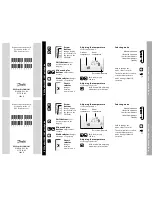
In Baudot and AMTOR, Russian transmitters use a third register to transmit
Cyrillic characters in addition to the LTRS and FIGS. They use LTRS to transmit
the Roman alphabet. As LTRS and FIGS characters are used to access the first
and second registers, they use the BLK or NUL character (00) to access the third
register. The PK-900 displays third-register characters as lower case
alphabetic characters, and all FIGS characters as in CODE 0 with the following
exceptions:
Character CODE 2 English pronunciation
FIGS-F $7C | E
FIGS-G $7B { SH
FIGS-H $7D } SHCH
FIGS-J $60 ' YU
3rd-Q $71 q YA
If several words end in "OJ", "OW" or "OGO" the transmission is probably Russian.
There is no separate Baudot combination for the CH character. The Russians use
a "4" because the Cyrillic character for CH resembles a "4".
It is safe to leave CODE set to 2 if you are not sure which alphabet the
transmitting station is using. You will be able to see the message in either
alphabet with minimal garbling, and you can then set CODE to either 0 or 3.
Another interesting side effect of being able to send and receive in CODE 2 is
that it is now possible to send and receive both upper and lower case text in
Baudot and AMTOR modes. To do this, both stations must have CODE 2 enabled
and of course both must be running 1992 or later firmware in their PK-900's.
Other users will see only upper case characters and not be aware that anything
unusual is happening, as the feature merely inserts NULL characters at strate-
gic times. An AEA PK-900 using CODE 2 in QSO with a unit in CODE 0 (or any
other equipment) will exchange data in upper case only, with no adverse ef-
fects.
This feature may be advantageous to users of the AMTOR MailDrop who want their
messages to be forwarded to the packet network. The ability to send and receive
upper and lower case characters in AMTOR should improve message readability when
it is translated to Packet and vice versa.
CODE 3: Transliterated Cyrillic
This code is similar to CODE 2, except that some characters are transliterated
into English phonetic equivalents for easier reading.
CODE 2 CODE 3
w V
v ZH
h KH
c TS
~ CH (Morse only)
{ SH
] SHCH
x '
| E (RTTY only)
' YU
q YA
1/93 A-35
Summary of Contents for PK-900
Page 14: ...The rest of this page is blank 3 93 TOC 10 ...
Page 86: ...This page is used to make the number of pages in this chapter an even number 1 93 4 44 ...
Page 114: ...The rest of this page is blank 1 93 6 16 ...
Page 136: ...The rest of this page is blank 1 93 7 22 ...
Page 142: ...The rest of this page is blank 1 93 8 6 ...
Page 178: ...The rest of this page is blank 3 93 11 22 ...
Page 296: ...3 93 6 ...
Page 297: ...APPENDIX B 1 93 B 1 ...
Page 298: ......
Page 299: ......
Page 300: ......
Page 301: ......
Page 302: ...APPENDIX B 1 93 B 2 ...
Page 303: ...APPENDIX B 1 93 B 3 ...
Page 304: ...APPENDIX B 1 93 B 4 ...
Page 305: ...APPENDIX C PK 900 Display Board PARTS PICTORIAL 1 93 C 1 ...
Page 306: ...PK 900 Main Board Logic Section PARTS PICTORIAL 1 93 C 2 APPENDIX C ...
Page 307: ...PK 900 Main Board Logic Section PARTS PICTORIAL 1 93 C 3 ...
Page 308: ...3 93 C 4 ...
Page 309: ......
Page 310: ......
Page 311: ......
Page 312: ...3 93 D 4 ...
Page 318: ...D ...
Page 319: ...D ...
Page 320: ...D ...
Page 321: ...D ...
Page 322: ...D 9 99 E 10 ...
Page 323: ...D ...
Page 326: ...PK 900 Gateway Option Supplement 2 This page intentionally left blank ...
Page 351: ...27 PK 900 Gateway Option Supplement This page intentionally left blank ...
Page 352: ...PK 900 Gateway Option Supplement 28 ...
Page 365: ...TNC GPS Upgrade Addendum 13 13 13 13 13 ...
Page 369: ......
Page 370: ...Figure B REMOVE VIA ...
Page 373: ...1 PK 900 PSK Sound Card Interface Upgrade Kit A 06265 Installation and Operation Manual ...
Page 383: ...11 ...
Page 384: ...12 ...
Page 389: ...17 Section 5 PK 900 PSK Sound Card Interface Schematic Diagrams ...
Page 392: ......
















































